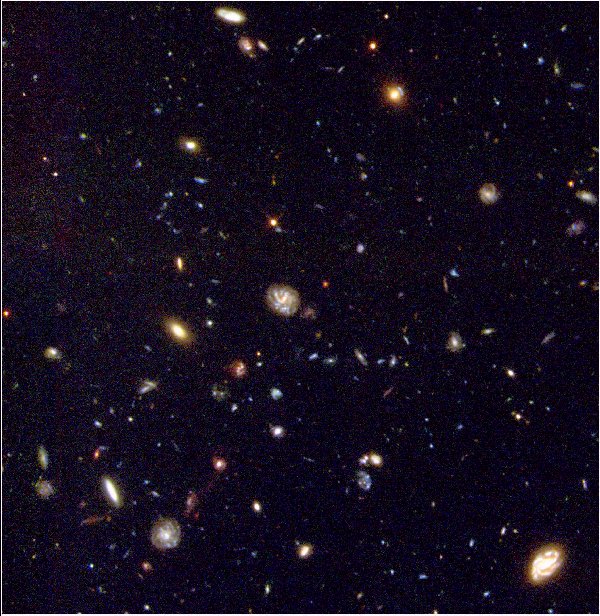
About 15 billion (a billion is 1,000,000,000 or 109) years ago our Universe began in a violent explosive event ... This is its story.
Many of us are familiar with the term "Big Bang", the start of our Universe. But that's about the level of detail many get to, or want to get to. Proposing and discussing theories of the Universe is rather daunting, although humans have been doing just that for several thousand years. However in the 20th century, cosmology has become a "testable" or quantifiable science.
Recent progress in cosmology and astronomy has been remarkable. For example, it was only in the third decade of the 20th century that galaxies were proven to be separate bodies of billions of stars distributed across vast amounts of space, not, as many thought, gaseous nebulae inside our own Galaxy. Today, using the high resolution capabilities of Hubble Space Telescope (HST) and the large light gathering abilities of 8-10 metre class ground based telescopes (eg. Keck I and II; European Southern Observatory Very Large Telescope; Gemini North and South, Hobby Eberly Telescope) we now routinely detect galaxies that are observed when the Universe was only 5-10% of its present age.

| Key concept: Unfortunately the term "Big Bang" may not be the best to describe the beginnings of the Universe. "Big Bang" conjures up the picture of some huge firecracker exploding! A gigantic thermonuclear explosion may be more apt, though even that does not do the event justice. We also may think, albeit wrongly, of the Big Bang occuring in the centre of our Universe, and then expanding to fill some pre-existing void. However at the moment of creation our Universe consisted of a infinitesimally small region of space at infinite density, and space itself expanded from that initial region. "Big Bang" was coined in the late 1940s by Fred Hoyle, and it has rightly or wrongly stuck as the name of the beginning of our Universe. |
|---|
The Friedman-Lemaître solutions of Einsteins (1916) General Relativity theory predict an expanding Universe. The underlying assumption of the theory is that the laws of physics are the same everywhere and at all times. At some early stage though the theory will not adequately describe the Universe because the Big Bang model extrapolates back to a singularity, a point of infinite density about 15 billion years ago. Close to this time General Relativity, based on gravity, will fail to describe the physical state of the Universe. However the general concept of the Big Bang has solid support and we now list the three major pieces of evidence that support the Big Bang model.
1. Observational verification of expansion. Edwin Hubble, substantially building on initial velocity measurements of Slipher, determined that the vast majority of galaxies are moving away from us, and that the velocity of their recession is proportional to their distance from us. Therefore close galaxies possess small velocities, distant galaxies are receeding with the largest velocities. This is commonly referred to as the Hubble expansion. This expansion would be observed from any galaxy, not just ours. The constant of proportionality that links the distance of a galaxy to its recession velocity is called the Hubble constant, H0. Going back in time will lead to a period of extreme space densities and even further to a singularity, the moment of the Big Bang.

2. Predicted and observed abundances of light elements. Element abundance predictions based on the creation of light atomic nuclei (eg. Deuterium, 2H; 4He; 3He; 7Li) during the first few minutes of the Big Bang agree extremely well with those observed. The model predicts that primeval helium was formed in the first few minutes and it should be about 25% of the total mass of the Universe. This helium content agrees well with that observed in stars and gas clouds.
3. Discovery of the Cosmic Microwave Background (CMB). The discovery of background radiation in 1965, consistent with relic energy from the Big Bang was a landmark finding that firmly consolidated the model. The spectrum and temperature of the radiation, 2.7° Kelvin (K) that we observe are consistent with relic radiation left over from a Big Bang event.
| The Kelvin temperature scale is similar to the Celsius scale except the zeropoint of the Kelvin scale is -273° Celsius. At this temperature particles are in their lowest energy states. |
|---|
The CMB has a "blackbody" temperature of 2.7° K.
| A blackbody is an object that completely absorbs radiation that falls on it, and then emits that radiation such that the spectrum of the radiation is described by one parameter only, the temperature of the body. Stars behave like blackbodies. |
|---|
The "blackbody" nature of the CMB is exactly that expected from an initial (Big Bang) "fireball" of radiation. The observation of the radiation later gained Wilson and Penzias the Nobel Prize in Physics. However the radiation had probably been detected earlier by Ohm (in 1961), and had been predicted, albeit with a large allowed temperature range, by Alpher and Hermann in the mid-1940s. The background had also been unknowingly detected in the early 1940s by McKellar who observed cyanogen molecules in interstellar clouds that had temperatures of 2-3° K.
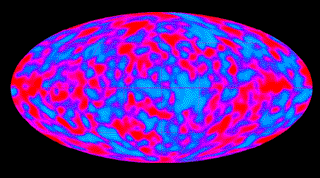
The Big Bang model is just that, a model. It is not a theory and therefore does not predict values of parameters that can constrain the type of Universe we inhabit. Two observable parameters that can constrain the physical properties of our Universe are the mass density, Omega, and the rate of expansion, the Hubble constant H0, and the quest to determine these is ongoing. Once Omega and H0 are known, an estimate of the age of the Universe can be made.
Omega is usually defined as the ratio of the amount of matter in the Universe to that required to exactly halt the observed expansion of galaxies. Hence an Omega greater than 1 infers that enough matter exists to stop the expansion and at some stage start a contraction of the Universe. The contraction would end in what is commonly referred to as the "Big Crunch". This type of Universe is called "closed". For an Omega less than 1, an "open" Universe, the expansion of the Universe will always overcome the force of gravity associated with its constituent mass and the expansion will continue forever. For an Omega = 1 exactly, the Universe is regarded as "flat or critical", and it is finely balanced between infinite expansion and eventual collapse, and its expansion will never quite finish. The density of matter for a flat Universe, the critical density, is 5 x 10-27 kilograms per cubic metre or about five atoms per cubic metre!
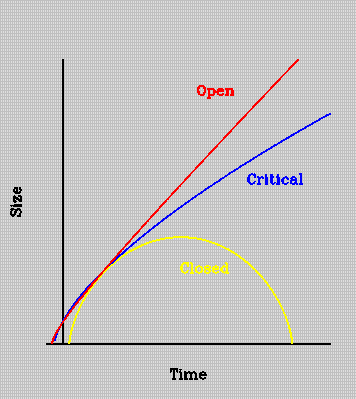
The Hubble Constant, H0, (usually expressed in kilometres per second per Megaparsec; - ie. velocity per distance, where 1 Megaparsec is 1 million parsecs, or about 3.3 million light years) technically is not a constant! The general expansion of the Universe should be slowing down due to gravitational effects (but see later in the section "Return of the Cosmological Constant"), meaning that the present epoch observed value of H0 will be smaller than it was in the past. Substantial effort has and continues to be made to accurately measure H0.
One of the current and best methods to determine H0 involves the observations of Cepheid (variable brightness) stars in distant galaxies by HST. The period of their brightness variation is related to the stars intrinsic brightness. We know how bright nearby Galactic Cepheids are and their distances, hence a distance can be derived to the more distant Cepheids and their host galaxies. An estimate of H0 has been calculated, about 70 km/s/Mpc, which suggests an age of the Universe of 14 billion years but possibly as young as 12 billion years. Distance measurements, such as those derived from Cepheid observations, that rely on secondary distance estimates (eg. distances to the Hyades star cluster, the Large and Small Magellanic Clouds, the Andromeda galaxy - Messier 31) usually have the largest errors however.

One of the more promising techniques to recently emerge involves a "single step" measurement of H0. This uses light travel delay times in gravitational lenses. These lenses are caused by the gravitational bending of light from a distant, bright background source (eg. a Quasar) around a less distant, massive foreground object (eg. a large galaxy) acting as a lens. In theory an estimate of H0 can be produced that is largely dependent only on the accuracy of the physical model used to describe the lens system. This technique has produced estimates of H0 accurate to 10% or less, and these are also around 70-80 km/s/Mpc.
Classical tests - Ages of Globular Clusters, Standard Galaxies and the abundance of Deuterium.
Several types of classical observations have been used to experimentally determine Omega, H0 and the age of the Universe. The first is a determination of the age of constituent matter in the Universe. Observations of globular clusters (eg. that produce a luminosity-temperature or Herzsprung-Russell diagram of its constituent stars) in combination with theoretical models of stellar evolution (that predict similar aged stellar evolutionary tracks called "isochrones") allow predictions of the age of the cluster to within 10-20%.
If the globular cluster ages are accurate (the oldest ages are estimated at about 12 billion years) then this places a lower limit on the allowed age of the Universe, and broad limits on Omega and H0. You will notice a problem that the estimated oldest ages of globular clusters (about 12 billion years) are about the same age as the youngest allowed age of the Universe. This is not a critical problem as the errors in both determinations are quite large, but could become more important if derived globular cluster ages increase.
The measured abundance of Deuterium, 2H, can also place constraints on the type (open or closed) of Universe we inhabit. Deuterium is not made in stars (it can actually be destroyed in stars) but during the Big Bang. Hence the observed abundance is a lower limit to that produced in the early stages of the Big Bang. The open Universe model predicts a production of one deuterium atom per 105 atoms, whilst a closed Universe should have one deuterium atom per 1010 atoms. The observed deuterium abundance is much nearer to one part in 105, therefore an open (Omega < 1) Universe is favoured.
Modern tests - The large scale structure of matter and radiation.
Dark Matter does matter
The kinematics of individual galaxies (in particular the motion of constituent stars and gas) and the motions of galaxies in groups or clusters of galaxies strongly suggest that much more matter exists in them than is inferred just by their luminous (eg. stars, gas) content. In some extreme cases (both small galaxies and large clusters) the percentage of this hidden or dark mass could be as large as 95%. This is an astounding result and suggests that the predominant mass of the Universe may be in the form of non-luminous "dark matter" . The candidates for Dark Matter are numerous, and include low mass dwarf stars, neutron stars, hydrogen (either neutral, molecular or ionized), black holes (either primordial or produced by stellar collapse), massive neutrinos, magnetic monopoles, particles predicted by supersymmetry (the as yet undetected gravitinos and photinos) or again undetected axions, (particles with extremely small masses).
It is obvious that if Dark Matter is the dominant form of matter in the Universe, its influence on the formation and evolution of structure (ie. galaxy clustering) will be paramount. In fact, the observed distribution of galaxies can be used to broadly constrain the "candidates" of Dark Matter. Over the last three decades it has been found that galaxies are not distributed randomly in space. Galaxies tend to group or cluster, in filaments, sheets or cells. Large voids exist in space where nearly no galaxies exist, whilst other structures that resemble the surfaces of interconnecting soap bubbles harbour a substantial fraction of galaxies.

| Key Theory: In the 1980s the Cold Dark Matter (CDM) model of large scale structure formation was introduced. CDM is thought to consist of massive particles produced in the Big Bang that have relatively low (non-relativistic) velocities. Computer simulations of various types of CDM Universes agree reasonably well with the available data on large scale structures. |
|---|
Dark Matter soup - Just a pinch of baryons
The presently favoured models of the Universe consist of Omega = 1, with about 70% CDM, about 30% Hot Dark Matter (HDM, high velocity, relativistic particles, eg. massive neutrinos) and a few per cent baryonic matter (objects consisting of protons, neutrons, eg. galaxies, stars, gas, us!).
| Key Observation:In 1998 a potentially important discovery was announced. A team of Japanese and American physicists have found evidence that neutrinos do possess mass and that they alternately change their identities in time as they travel. The results come from Super-Kamiokande, a $100 million experiment in a 12.5 million gallon, stainless steel-lined cavity carved out beneath the Japanese alps, filled with ultra pure water and observed by 13,000 large area light detectors. One of the three presently known kinds of neutrinos (the "flavours": electron, muon and tau), the muon, disappears and reappears (or flips from muon to another flavour, possibly the tau) as it travels hundreds of kilometres through the earth. The energy and flight distance provide a measure of the difference between neutrino masses. The implied mass difference between the two types is about 0.1 eV (where eV is electron Volts, an energy unit). However the sum of the (three known) neutrino masses has to be 5 to 7 eV to form a major component of Dark Matter. If HDM is dominated by neutrinos then based on these results it is not a large component of DM. Maybe there other forms of HDM? |
|---|
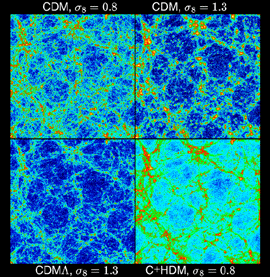
Structure in the Cosmic Microwave Background
COBE was a satellite used to accurately observe the structure of the cosmic microwave background (CMB). COBE could resolve structures which extended about 7 degrees, and it found statistical evidence of minor structure or non-uniformity in the CMB. This non-uniformity are the seeds of galaxies and clusters of galaxies that we see today. Some gravitational instabilities had to exist in the early Universe to initiate galaxy and cluster formation, and these "structures" seen in the COBE maps show just that . The COBE structures tell us how big the irregularities were when the microwave radiation was produced, about 300,000 years after the Big Bang.
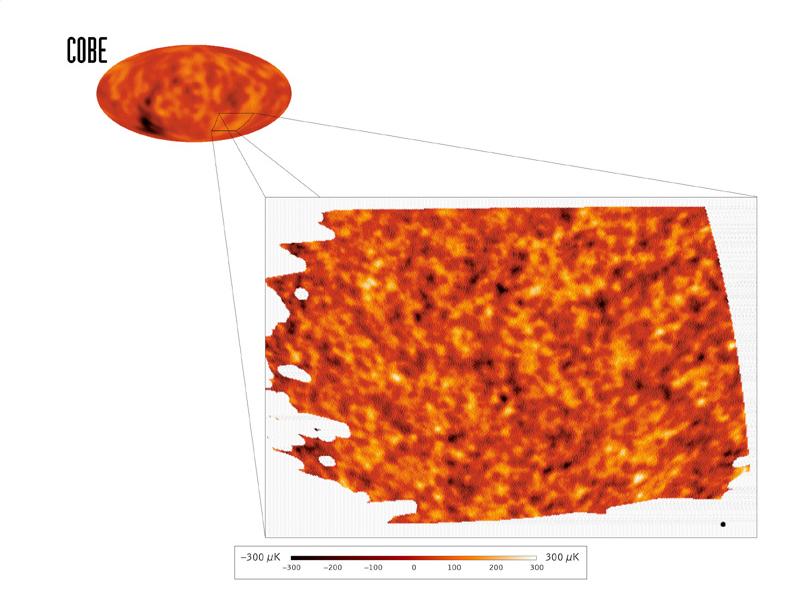
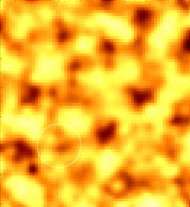
The search for two numbers: And the winners are ...
The generally agreed observational range of Omega is between 0.1 and 0.3 (ie. indicating an open Universe), although if most of the matter in the Universe was dark (which is strongly supported by the observations of distant supernovae, see below), Omega could in theory get close to, or equal 1 (the critical density). Recent observations of the CMB at high spatial resolution now strongly supports a flat universe with Omega = 1 exactly.
Determining H0 has proven somewhat easier than Omega. The present day best estimate for H0 is 60-70 km/s per Megaparsec. As mentioned before, the emergence of "single-step" measurements such as using gravitational lens systems will constrain H0 even further.
The beginning of the Big Bang is sometimes referred to as the primeval fireball. Cosmologists and particle physicists can predict quite accurately what physical processes occur onwards from about 10-3 seconds after the start of the Big Bang at t=0. Before this time the physical processes rely heavily on the interplay between the fundamental forces of nature (gravity, electromagnetism, strong and weak forces). The study of these forces at the earliest times, and their behaviour is known as GUTs (Grand Unified Theories).
GUTs suggests that at the moment of creation there was no distinction between the four forces; all were equally strong and were governed by one set of rules. A promising line of attack in developing GUTs is theoretical "superstrings" or "cosmic strings". Cosmic strings are faults in space-time, where GUTs physics still applies today. Strings would be produced about 10-35 s after t=0, and they could play an important role in the formation and evolution of structure in the Universe.
The temperature of the fireball drives the resulting mix of particles and radiation, and we can divide the Universe evolution into four stages; heavy particle era; light particle era; a radiation era and the present day era of matter. As the Universe expands its temperature and density decline.
A Fireball in four parts.
Heavy particle era - temperature > 1012K, time < 10-6 s - Massive particles and antiparticles are made from energetic photons and these particles can also be annihilated.
Light particle era - 1012K > temperature > 6 x 109K, 10-6 s < time < 6 s - As the temperature declines not enough energy exists to create many massive particles, so light particles (electrons) are preferentially formed. Protons and electrons interact to form neutrons. As the temperature falls to 6 x 109K photons do not have enough energy to form proton-electron pairs, and the radiation era begins. Many neutrons decay into protons and electrons, but a reservoir of neutrons is left to play an important part in the radiation era.
Radiation era - temperature approx. 109K, 6 s < time < 300 s - Key nuclear reactions occur in this era. The nuclei of simple elements are made from the remaining neutrons and protons. Deuterium (2H) is made by combining a neutron and proton. Further reactions create 4He (normal helium) at about 25% of the total mass (with the remaining ~75% being hydrogen). Nucleosynthesis stops at the production of 4He because at this stage (unstable) nuclei with atomic masses of 5 or 8 can only be bypassed by stellar nucleosynthesis, and stars have not yet formed!
Matter era - temperature < 3000 K, time > 1 million years - At about 1 million years the temperature has dropped to about 3000 K, which allows nuclei to capture electrons and form neutral atoms (this process is called recombination). Radiation and matter decouple, such that matter becomes transparent to radiation. The CMB detected by Penzias and Wilson (and COBE) is emitted. Matter can now clump together because previously radiation could exert pressure to combat gravity. Galaxies and stars eventually form. Stellar nucleosynthesis produces heavy (eg. C,N,O,Fe) elements. Gravitational effects determine the large-scale structure of the Universe. The Big Bang theory developed after about 15 billion years!
In the beginning: Planck time and the use of force.
We can now break down the moment of creation and identify various specific times in the early Universe corresponding with the appearance of the presently known forces of nature.
| Key Theories: The earliest moment that can be described is at t=10-43 s, known as the Planck time. According to quantum mechanics, time intervals less than 10-43 s, or distances less than the corresponding "Planck length" of 10-35m cannot be defined. We may think of these time intervals and distances as probablility fluctuations, appearing (out of nothing) then disappearing at will. Progressing from the Planck time, the unified (GUT) forces then started to separate, with gravity first. When the Universe was t = 10-25 s old and 1027 K the strong and electroweak forces separate. Then the separation of electroweak into the weak and electromagnetic forces at t = 10-7 s occurs, when the temperature had fallen to 1014 K. |
|---|
The cosmic fireball then continues through the Heavy particle era, and progresses into the Light particle, Radiation and Matter eras (as described above).
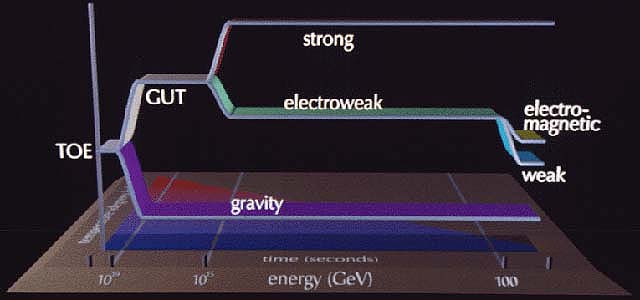
So far, so good? Not quite. Whilst observationally we would infer a low value of Omega, there are now arguments in favour of a high value of Omega, close to 1 if not equal to it. These arguments are driven by theoretical concerns based on two major problems with the Big Bang model.
The Cosmological Flatness Problem The standard Friedman-Lemaître models have Omega approximately 1 at the Big Bang and then evolving away from 1 thereafter. Models starting with Omega slightly higher than 1 rapidly develop larger values of 1 as the Universe ages. Universes with Omega slightly less than 1 rapidly possess smaller values of Omega. Our observed lower limits to Omega of 0.1 - 0.3 are still, based on these scenarios, very close to a flat, Omega=1 Universe. If the Friedman-Lemaître models are correct then why is Omega not more like 106 or 10-4 after 15 billion years of evolution?
The Horizon Problem This problem occurs because of the finite speed of light and the observed regularity of the Universe. The COBE background radiation maps were, despite small irregularities, smooth to 1 part in 10,000 across the whole sky. How then does radiation coming from one part of the sky "know" how strong it should be to agree with such remarkable precision with radiation from the opposite part of the sky? The crux of the problem lies in the fact that the 2.7° K background radiation was emitted when the Universe was approximately 300,000 - 500,000 years of age. Based on light (ie. information) travel time however, at that stage only regions of the sky within 2 degrees could be in contact. This is the horizon distance. So we may expect to see "patchiness" in the sky background at scales of 2 degrees. Instead, somehow the radiation knew how strong it had to be on a global or "universal" scale to produce such a regular radiation field!
Inflation - Tennis Anyone?
Is the Big Bang model dead because of the Horizon and Flatness problems? Not quite. In fact the Horizon and Flatness problems initiated an important variation of the model, called the Inflationary Universe model, that went a long way to fully integrate quantum and particle physics into the early evolution of the Big Bang.
| Key Theory: The inflation model solves the horizon problem by reducing the size of the early Universe so that the Universe was smaller than its horizon distance. At this stage the fireball was homogeneous allowing a "fine tuning" of the temperature. Then, a period of rapid expansion (ie. inflation) occured preserving the temperature structure (eg. the COBE background map). All of this happens before 10-25 s has elapsed and the Universe is the size of a tennis ball! |
|---|
The flatness problem is also solved by inflation. The rapid expansion of inflation can be visualised by imagining a balloon being inflated. The initial curvature of the balloons surface gets flattened out as it expands. Similarly, the expansion of spacetime by a factor 1050 during its inflation period produces a Universe indistinguishable from a flat Universe with a density close to critical by the time the Universe is tennis ball size. The so-called fine tuning of Omega to be close to 1 at early times (to satisfy the Friedman-Lemaître model constraints) can be achieved by inflation. Inflation actually drives Omega towards 1.
This work was initiated in the 1980s by Guth and has been modified by Linde, Albrecht and Steinhardt into what is now called the "new" inflationary hypothesis, which can be regarded as a work in progress. If it turns out, as we currently observe, Omega is not 1 then do we abandon inflation? Maybe not; some new models of inflation can produce an open Universe. On the other hand if Omega is 1 then this may not categorically prove that "inflation" occured. Possibly another mechanism occured that "fine tuned" the early Universe.
Return of the Cosmological Constant - We're so sorry, Uncle Albert.
In 1917 the consensus view was that the whole Universe consisted of a static galaxy, our Galaxy. The external nature of galaxies, and their (recessional) motions had yet to be discovered. Einstein had to place predictions of the Universe based on his General Theory of Relativity in this context. However his theory predicted either an expanding or contracting Universe. To satisfy the observational picture of the Universe at that time, he introduced a term (the Cosmological Constant, or Lambda) into the solutions of his theory, which kept the Universe static. (Lambda, if positive acts as a repulsive force, and if negative acts as an attractive force, ie. like gravity). Lambda is an additive term incorporated into the total Omega value. For example, a closed Universe may occur if the observed limits of 0.1-0.3 measured for Omega is combined with a Lambda of 0.9-0.7. Ten years after 1917 Hubble had shown that the Universe was expanding, and Einstein later was reported to have said that the introduction of Lambda had been the "biggest blunder of my life".
Hang on Albert! Over the last few years teams of astronomers have been observing distant type Ia supernovae (white dwarf stars that have accreted matter from a companion star, reaching critical mass, and explode with the same absolute brightness). These very bright cosmic lighthouses that can be seen at tremendous distances provide distance information and allow the measurement of Omega and Lambda. Using careful observational techniques two separate teams of astronomers have come to an extraordinary conclusion.
The distant supernovae are fainter (and thus further away) than expected, suggesting the presence of a large-scale repulsive force, that accelerates the Universes expansion. Hence, there could be no Big Crunch end to our Universe! The expansion of the Universe could have sped up since the supernovae exploded billions of years ago, implying that about 70% of the Universe's mass-energy could exist as a Lambda acting in the opposite sense to gravity.
| Key Observation: A recent research paper by one of the supernovae teams suggests that the Universe is eternally expanding, with a positive Cosmological Constant, an expansion that is accelerating, and a dynamical age of 14 billion years. Science magazine rated this story as the most important scientific discovery in 1998, and if the initial results are confirmed it will become one of the most important discoveries of all time. |
|---|
Presently, astronomers are searching for ways nature might alter (dimm) the brightness of these distant, supposed homogeneous, stellar explosions to make them look further away, but so far, no stand out possibilities exist. Astronomers had previously disliked the "artificial" insertion of Lambda into the solution of the General Relativity theory by Einstein. Now, there appears new evidence for such a term. Einsteins mistaken "blunder" may prove correct after all but for the wrong reason!
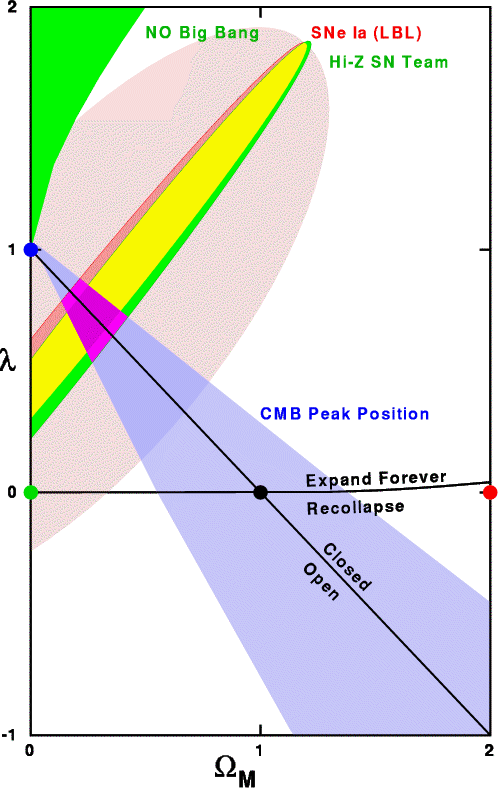
Cosmology is proceeding rapidly along several directions. Continued efforts to map the large scale structure (and its evolution) of the Universe is occuring (including the 2 degree field, 2dF, survey of 250,000 galaxies by the Anglo-Australian Telescope, and the even larger Sloan Digital Sky Survey, SDSS, which will produce distances for 1 million galaxies over a 5 year period). This data will help constrain the form of Dark Matter and theories of galaxy and cluster formation. In fact theoretical models of large scale structure based on the 2dF and SDSS volumes of space to be sampled have already been created.
Specific observations, such as gravitational microlensing studies (one is currently being carried out by a team of New Zealand and Japanese astronomers using a telescope at Mount John University Observatory, near Lake Tekapo) and high energy particle physics experiments (eg. at Super-Kamiokande in Japan), are being used to constrain the possible constituents of Dark Matter.
The quest to accurately determine Omega is paramount, as is developing the quantum mechanical and inflationary models of the very early Universe. Space and ground based telescopes are continuing to detect and analyse distant galaxies that are probably dominated by first generation stellar populations. The most distant galaxy we know of existed when the Universe was only 1-3 billion years old. Thus determining the important epoch of galaxy formation is probably within our grasp. Confirming the existence of Lambda is critical. Supernovae searches are continuuing and even more distant examples are needed to consolidate the initial findings of a large, positive Lambda.
As well as the new 10 metre-class ground-based telescopes, the Next Generation Space Telescope (to be launched sometime after 2007), and the X-ray telescope Chandra (launched in 1999), probably the most important instrument for early Universe cosmological studies will be the Planck Surveyor.
The European Space Agency hopes to launch the Planck Surveyor satellite in 2006. It will greatly improve upon COBE, and map the microwave background simultaneously at 9 frequencies and at spatial resolutions of less than 1/10 of a degree. Planck offers the tantalizing possibilities of accurately measuring Omega, H0, the make-up of Dark Matter, and the Cosmological Constant. If all goes well by the end of the first decade of the new millennium we could know the future of our Universe.
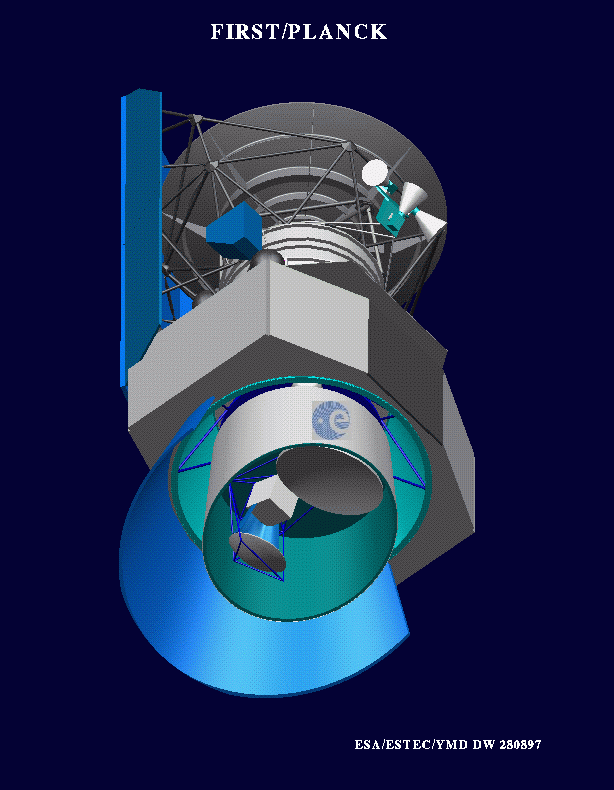
Magazines: Sky and Telescope; Sky and Space; Astronomy.
Ronan, C.A. 1991, The Natural History of the Universe, (MacMillan: New York)
Gribbin, J. 1998, In Search of the Big Bang, (Penguin: England)
Guth, A. 1997, The Inflationary Universe: The Quest for a New Theory of Cosmic Origins. (Addison-Wesley: Reading).
Coles, P. 1998, "The end of the old model Universe", Nature, vol. 393, 741.
Barrow, J. and Tipler, F. 1998, The Anthropic Cosmological Principle, (Oxford University Press: Oxford).
Peebles, P.J.E. 1993, Principles of Physical Cosmology, (Princeton University Press: Princeton).
I would like to thank the students of Gisborne Intermediate School who visited Carter Observatory for inspiring me to write this article. Thanks also to Professor John Lekner and Mike Reid who provided comments on a first draft.
Glen Mackie is Lecturer and Assistant Coordinator Swinburne Astronomy Online (SAO) in the Centre for Astrophysics and Supercomputing, Swinburne University of Technology.
Hubble Deep Field - South (oposite.stsci.edu/pubinfo/pr/1998/41/content/9841ay.jpg): The Space Telescope Science Institute is operated by the Association of Universities for Research in Astronomy, Inc. (AURA), for NASA, under contract with the Goddard Space Flight Center, Greenbelt, MD. The Hubble Space Telescope is a project of international cooperation between NASA and the European Space Agency (ESA).
Expansion of the Universe - (imagine.gsfc.nasa.gov/Images/science/expand.gif): eunice.eng@gsfc.nasa.gov
COBE map (www.ncsa.uiuc.edu/Cyberia/Cosmos/SeedsStructure.html#cobe.three): This image of the microwave sky was created from COBE DMR data sets. It shows a "reduced map" (dipole and galactic emission have been subtracted), which gives full response to variations in the cosmic temperature. The COBE datasets were developed by the NASA Goddard Space Flight Center under the guidance of the COBE Science Working Group and were provided by the National Space Science Data Center (NSSDC).
Open, Closed, Critical Universes (www.imsa.edu/~bug/expansion.html)
Modern Day Hubble Diagram (www.hubbleconstant.com/images/a2218plot_big.jpg - webmaster@hubbleconstant.com)
Large scale structure (www.ncsa.uiuc.edu/Cyberia/Cosmos/WallsVoids.html#SheetsVoids) Courtesy: Margaret J. Geller and Emilio E. Falco, Harvard-Smithsonian Center for Astrophysics. Credit: Geller, da Costa, Huchra, and Falco.
Comparison of Four Popular Cosmological Models (sdcd.gsfc.nasa.gov/ESS/news.sc95_slides.html) Credits: Michael Warren, Wojciech Zurek, Los Alamos National Laboratory; John Salmon, Caltech; Peter Quinn, European Southern Observatory
Comparison of COBE and BOOMERANG CMB observations (www.physics.ucsb.edu/~boomerang/press_images/raw_images/COBE=BOOM72or.jpg)
Cosmic Background Imager observation of CMB (www.astro.caltech.edu/~tjp/CBI/)
Evolution of Forces (www.ncsa.uiuc.edu/Cyberia/Cosmos/Images/Odyssey.Forces.bajuk_lg.jpg) The image was excerpted from scientific visualizations featured in a video entitled "Galactic Odyssey." This video was produced by NCSA for NHK, the Japanese Broadcasting Co. Research: Charles R. Evans, University of North Carolina at Chapel Hill Visualization and Animation: Matthew Arrott; Mark Bajuk; NCSA Visualization Group Video post-production: NCSA Media Technologies Group Copyright © 1992, Board of Trustees, University of Illinois and NHK
Plot of OmegaM, lambda plane (www.astro.ucla.edu/~wright/cosmo_constant.html)
Planck Surveyor (astro.estec.esa.nl/SA-general/Projects/Planck/pictures/prephaseb/FPL2n001.gif)
baryon: A massive elementary particle made up of three quarks. Neutrons and protons are baryons.
baryonic matter: Ordinary matter as we know it consists largely of baryons, as opposed to hypothetical matter that might theoretically exist. Both kinds have mass, and either kind can be dark matter.
Big Bang: A model of the Universe beginning at very high density and temperature, which expands and cools to become the Universe we observe now.
blackbody: An object with a constant temperature that absorbs all radiation that hits it.
cold dark matter (CDM): A type of dark matter that was moving at much less than the speed of light 10,000 years after the Big Bang. CDM would exist as exotic particles that only weakly interact with radiation and baryons. CDM would make matter clump into small-scale units with galaxies forming first. Clusters and superclusters would form later.
closed universe: A cosmological model in which the Universe is finite, and will eventually recollapse. The density of this Universe is more than the critical density.
CMB: Cosmic Microwave Background radiation, also CMBR, CBR and the "3 K blackbody radiation". Radiation left over from the Big Bang which has cooled by expansion to a temperature slightly less than 3 degrees above absolute zero.
cosmic strings: Tubelike configurations of energy that might arise in the early universe (and remain in our present Universe). They may exist as line-like defects in space-time.
cosmological constant: A term in Einstein's general relativity equations that works in the opposite sense of gravity. Einstein used it to force the existence of a static Universe. Usually denoted by the capital Greek letter Lambda when expressed with units of inverse length squared, or by the lower-case Greek lambda when normalized to the critical density (like Omega).
cosmology: The study of the contents, structure, and evolution of the universe from the beginning of time to the infinite future.
critical density: The density of the Universe necessary so the expansion rate of the Universe is just barely sufficient to prevent a recollapse. Omega is the mass density of the Universe normalised to units of the critical density.
dark matter: A form of matter that does not emit light, absorb light, or scatter light. Its only interactions are gravitational. So far, it has not been detected. This "extra-mass" is strongly inferred to exist due to the fast motions of galaxies in clusters, and of stars in galaxies.
density: The amount of matter in a volume divided by the volume, so the units are grams per cubic centimeter. Water has a density of 1 gram per cubic centimeter.
Doppler: 19th century physicist who discovered the variation in the wavelength of waves caused by motion of the source.
electromagnetic force: One of the four forces of nature. Electromagnetic interactions hold electrons in atoms, hold atoms in molecules, and are used in all electronic devices.
electroweak force: A unified force that combines the electromagnetic and weak nuclear interactions. Predicted by Weinberg and Salam, experimentally verified by Rubbia and van der Meer.
escape velocity: The minimum velocity that will allow an object to escape from a gravitational field.
general relativity: Einstein's laws of physics in which gravity is described by a curvature of space-time.
Gyr: Gigayear, or one billion years.
grand unified theory (GUT): A model for unifying the strong nuclear force, the weak nuclear force, and the electromagnetic force at very high energies. Ultimately, it is hoped to extend GUT to incorporate gravity (possibly by superstrings) to create a theory of everything (TOE). Several such GUTs have been proposed, but not yet experimentally verified.
gravity: One of the four forces of nature. The force depends on the masses of particles and their separations. Gravity has allowed galaxies, stars and planets to form.
gravitational potential: The gravitational energy per unit mass of a particle, equivalent to the acceleration of gravity times the height in ordinary circumstances on the surface of the Earth.
homogeneous: The same at all locations.
horizon: The edge of the visible Universe, but not the edge of the Universe since the Universe has no edge.
hot dark matter (HDM): A type of dark matter that was moving at close to the speed of light 10,000 years after the Big Bang. An example of a hot dark matter candidate is the massive neutrino. HDM would produce large-scale structures first (supercluster, clusters) which would then fragment into individual galaxies.
Hubble constant: Or Ho, the ratio of velocity to distance in the expansion of the Universe, so v = HD. The "o" [pronounced "naught"] on Ho means the current value, since the Hubble "constant" changes with time (but it is the same everywhere in the Universe at a given time).
inflation: A modification of the Big Bang model in which a large cosmological constant exists temporarily early in the history of the Big Bang (around t=10-35 secs), leading to a rapid accelerating expansion of the Universe, which is then followed by the normal Big Bang model with a decelerating expansion.
isotropic: The same in all directions. Anisotropic - not isotropic. Anisotropy - difference between different directions. In the standard color scheme for CMB anisotropy maps measured by the COBE DMR, red shows areas of the sky that are warmer, while blue shows the cooler regions.
non-baryonic: Not made up of neutrons, protons (ie. atoms) and thus not like any of the known chemical elements.
Nucleon: A neutron or a proton - one of the particles inside an atomic nucleus.
nucleosynthesis: Formation of atomic nuclei by nuclear reactions either in the Big Bang or in stellar interiors. Hydrogen, Deuterium, Helium and Lithium are made early on in the Big Bang. Heavier elements (eg. Carbon, Nitrogen, Oxygen) are produced in stellar interiors.
Omega: The ratio of the density of the Universe to the critical density (needed for eventual collapse).
open universe: A cosmological model in which the Universe is infinite and will expand forever.
parsec: A unit of distance used by astronomers, corresponding to a parallax of one arc-second. Equal to 3.085678 x 1013 kilometers, or 3.26 light-years. kpc: 1000 parsecs; Mpc: 1 million parsecs.
photon: A quantum of light, having wave and particle-like properties.
Planck time/length: t=10-43 secs. It is the shortest time interval that can exist; if two events are separated by less than this, we cannot say which comes before and which after. Prior to t=10-43 secs after the Big Bang, Einstein's General Relativity theory of gravity breaks down and a quantized theory is needed. Similarly, the related Planck length of 10-33 cm is the length scale below which space as we know it ceases to exist and becomes quantum foam.
QSO: quasi-stellar object. The first discovered QSO's were radio sources, leading to the name quasi-stellar radio sources, or QSRS, or quasars. These objects look like stars on an image of the sky, but their spectra show strong emission lines at high redshift. The redshift means that quasars are very far away, and are thus the most luminous objects in the Universe.
quantum fluctuations: The uncertainty principle in quantum mechanics leads to all allowed interactions occuring with some probability.
quantum foam: A foamlike structure of space that probably makes up the cores of singularities, and that probably occurs in ordinary space on scales less than the Planck length.
radiation era: The era up to 300,000 years after the Big Bang when radiation was the dominant constituent of the Universe.
redshift: The Doppler shift for objects receding from the Earth causes the wavelengths of light to get longer, and hence shift into the red part of the spectrum.
redshift (gravitational): Light is emitted at a longer (redder) wavelength in a gravitational field than in the absence of a gravitational field. Earth's gravity induces a gravitational redshift of 1 part in 109; a white dwarf star, about 1 part in 104.
singularity: A infinitely dense region of space-time where the known laws of physics break down, and the curvature of space becomes infinite.
space-time: The four-dimensional "fabric" that results when space and time are unified.
spectrum: Result of spreading out light by wavelengths. A rainbow is a natural spectrum. The eye is sensitive to waves from violet at 380 nm (nm: nanometre or 1x10-9 metre) wavelength to red at 700 nm wavelength, but astronomers now study electromagnetic radiation from gamma rays through X-rays, ultraviolet, violet, blue, green, yellow, orange, red, infrared and radio waves.
strong nuclear force: One of the four forces of nature. The strong nuclear force holds the particles in the nucleus of atoms together.
string (theory): An attempt to construct a model of elementary particles from one-dimensional "strings" rather than the standard zero-dimensional "points" of conventional particle physics.
superstring (theory): A 26-dimensional (or 10-dimensional) string that has a line-like topology in which all fundamental forces are unified. It is possible that our 3-dimensional Universe collapsed out of such a string. Strings have not yet been observed.
weak nuclear force: One of the four forces of nature. The weak nuclear force is responsible for radioactive decay as well as the fusion reactions in the Sun that provide heat and light for the Earth.